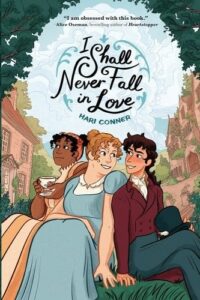Generally speaking, I’m used to queer historical fiction falling into two categories: depressing and trying to be historically accurate, or joyful and set in an imaginary version of history without bigotry. When I picked up I Shall Never Fall in Love, I was expecting the latter. After all, this is a book that draws heavily on Jane Austen novels and also has queer, nonbinary, and Black characters living in “high society”. I was pleasantly surprised to find this is a joyful queer story that also is well-researched and faces the racism, queerphobia, sexism, classism, and other bigotries of the time head on.
Eleanor is a young white woman who has grown up as part of an inseparable triad of friends, alongside Charlotte and George. Charlotte is her cousin, a young Black woman who grew up with Eleanor. George is white and nonbinary and is treated as a gender-nonconforming woman. When George’s parents died, they inherited the failing family estate. It’s immediately obvious to the reader that Eleanor and George are in love with each other, but it’s not obvious to them. Eleanor doesn’t understand why she can’t seem to muster up any interest in a gentleman suitor so she can marry well, like her late mother wanted for her.
One fun aspect of this story was the weaving together of multiple Jane Austen novel references. There’s an excellent “Badly done, Emma Eleanor” scene, and there’s plenty of nods to Pride and Prejudice. Likely there are many more references I missed, since I haven’t read all of Jane Austen’s works.
Speaking of that Emma moment, Eleanor is definitely a flawed main character. She’s oblivious to the racism Charlotte faces. She’s classist, lecturing her friends about coming across as not suiting their station and avoiding spending time with working class people. She can also be jealous and rude. But she’s also loving, loyal, and charming, and she is forced to face her flaws and tries to improve from there.
Although Eleanor and George take center stage, I appreciated the moments we get with Charlotte, who feels like a fully realized character even if she plays more of a supporting role. We see how strange it is for her to try to navigate a society that is racist and supports the slave trade while they simultaneously try to pretend that racism doesn’t exist. She’s practical and clear-eyed, and she eventually has to explain to Eleanor how she has different options available to her as well as different values. (Specially, not interacting with anyone who invests in the slave trade.)
It was also interesting to see George go on a subtle gender journey throughout the book, experimenting with clothing and hairstyles to affirm their gender. The narration refers to them with they/them pronouns, although these pronouns aren’t used by the characters, which I thought made a lot of sense. We also get a glimpse into the lives of other queer characters, showing how there’s always been a network of queer people finding each other across time and geography.
I was really impressed with how this YA graphic novel balanced a cute queer love story with historical accuracy about queer people and people of color’s experience in this setting. There are absolutely goofy moments with over-the-top cartoon expressions, but the story also doesn’t erase the everyday bigotry of this setting. There are notes at the end giving more context about queer and Black people’s lives in this setting in history. There are also some FAQs answered by the characters and an annotated bibliography for readers who want to learn more. This is a new favorite!



Leave a Reply